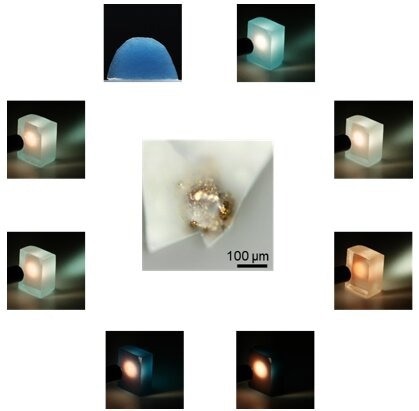Silicate glass is a common domestic glass that can be found in drinking glasses or windowpanes. For hundreds of years, the incorporation of gold nanoparticles (NPs) in silicate glass has been employed in art and ornamentation. These NPs influence how the silicate glass interacts with light via a process known as localized surface plasmon resonance.
 Tellurite glasses containing a ~200 μm gold particle (middle photo) and gold nanoparticles of different size and quantity (surrounding photos). Image Credit: Laurence Deziel
Tellurite glasses containing a ~200 μm gold particle (middle photo) and gold nanoparticles of different size and quantity (surrounding photos). Image Credit: Laurence Deziel
Applications ranging from colored glass to specialized optical components have been made possible by this unique light modulation characteristic. Since gold nanoparticles can uniquely regulate light, researchers are using these NPs to create novel optical functions in different types of glass.
Tellurite glass has drawn the most attention out of all the glass kinds that have been studied since it has a special set of characteristics. Due to its durability, low phonon energy, large transmission window, and high solubility of luminescent rare earth ions—which enable them to emit strong light throughout a broad spectrum range from visible to infrared light—tellurite glass is very simple to make.
These are crucial characteristics of sensor technologies, fiber optics, laser systems, and telecommunications technologies. Carefully controlling the size, shape, distribution, and number of the gold NPs is necessary to provide the appropriate light modulation behavior.
However, it has been shown that the so-called striking approach, which is frequently used to create gold NPs in silicate glass accurately, is insufficient to obtain fine control of gold NPs in tellurite glass.
Researchers including Professor Heike Ebendorff-Heidepriem and Dr. Yunle Wei from the Institute for Photonics and Advanced Sensing (IPAS), School of Physics, Chemistry and Earth Sciences, The University of Adelaide, Australia, Dr. Jiangbo Zhao from the School of Engineering at the University of Hull, United Kingdom, and colleagues in Germany have developed a novel method to form gold nanoparticles (NPs) in tellurite glasses, according to a study published in Light: Science & Applications.
The researchers came up with a new strategy by recognizing the shortcomings of the conventional striking method for producing gold nanoparticles (NPs) in tellurite glass and, by chance, finding gold NP creation in tellurite glass.
The team created entirely new procedures for both phases of the striking technique—(i) a controlled cold crucible corrosion technique to incorporate gold ions into the glass, and (ii) a glass powder reheating technique to convert the gold ions to gold nanoparticles—based on this advancement in knowledge and accidental discovery.
This is a perfect example of turning a serendipitous discovery into an innovative technology with potential for real-world impact, thanks to great teamwork among collaborators.
Dr. Yunle Wei, Technology Co-Inventor and Postdoctoral Researcher, Institute for Photonics and Advanced Sensing, School of Physics, Chemistry and Earth Sciences, The University of Adelaide
The invention of precise control over the creation of gold NPs in tellurite glass gives direction for creating and modifying the plasmonic characteristics of tellurite glass in the future for photonics research and applications.
Journal Reference:
Wei, Y, et. al. (2023) Controlled formation of gold nanoparticles with tunable plasmonic properties in tellurite glass. Light: Science & Applications. doi:10.1038/s41377-023-01324-x